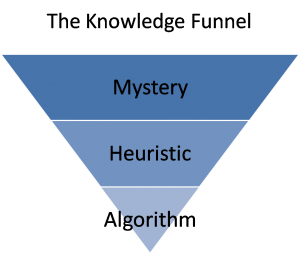
GUEST POST from Greg Satell
The rise of China over the last 40 years has been one of history’s great economic miracles. According to the World Bank, since it began opening up its economy in 1979, China’s GDP has grown from a paltry $178 billion to a massive $13.6 trillion. At the same time, research by McKinsey shows that its middle class is expanding rapidly.
What’s more, it seems like the Asian giant is just getting started. China has become increasingly dominant in scientific research and has embarked on two major initiatives: Made in China 2025, which aims to make it the leading power in 10 emerging industries, and a massive Belt and Road infrastructure initiative that seeks to shore up its power throughout Asia.
Many predict that China will dominate the 21st century in much the same way that America dominated the 20th. Yet I’m not so sure. First, American dominance was due to an unusual confluence of forces unlikely to be repeated. Second, China has weaknesses—and we have strengths—that aren’t immediately obvious. We need to be clear headed about China’s rise.
The Making of an American Century
America wasn’t always a technological superpower. In fact, at the turn of the 20th century, much like China at the beginning of this century, the United States was largely a backwater. Still mostly an agrarian nation, the US lacked the industrial base and intellectual heft of Europe. Bright young students would often need to go overseas for advanced degrees. With no central bank, financial panics were common.
Yet all that changed quickly. Industrialists like Thomas Edison and Henry Ford put the United States at the forefront of the two most important technologies of the time, electricity and internal combustion. Great fortunes produced by a rising economy endowed great educational institutions. In 1913 the Federal Reserve Act was passed, finally bringing financial stability to a growing nation. By the 1920s, much like China today, America had emerged as a major world power.
Immigration also played a role. Throughout the early 1900s immigrants coming to America provided enormous entrepreneurial energy as well as cheap labor. With the rise of fascism in the 1930s, our openness to new people and new ideas attracted many of the world’s greatest scientists to our shores and created a massive brain drain in Europe.
At the end of World War II, the United States was the only major power left with its industrial base still intact. We seized the moment wisely, using the Marshall Plan to rebuild our allies and creating scientific institutions, such as the National Science Foundation (NSF) and the National Institutes of Health (NIH) that fueled our technological and economic dominance for the rest of the century.
There are many parallels between the 1920s and the historical moment of today, but there are also many important differences. It was a number of forces, including our geography, two massive world wars, our openness as a culture and a number of wise policy choices that led to America’s dominance. Some of these factors can be replicated, but others cannot.
MITI and the Rise of Japan
Long before China loomed as a supposed threat to American prosperity and dominance, Japan was considered to be a chief economic rival. Throughout the 1970s and 80s, Japanese firms came to lead in many key industries, such as automobiles, electronics and semiconductors. The United States, by comparison, seemed feckless and unable to compete.
Key to Japan’s rise was a long-term industrial policy. The Ministry of International Trade and Industry (MITI) directed investment and funded research that fueled an economic miracle. Compared to America’s haphazard policies, Japan’s deliberate and thoughtful strategy seemed like a decidedly more rational and wiser model.
Yet before long things began to unravel. While Japan continued to perform well in many of the industries and technologies that the MITI focused on, it completely missed out on new technologies, such as minicomputers and workstations in the 1980s and personal computers in the 1990s. As MITI continued to support failing industries, growth slowed and debt piled up, leading to a lost decade of economic malaise.
At the same time, innovative government policy in the US also helped turn the tide. For example, in 1987 a non-profit consortium made up of government labs, research universities and private sector companies, called SEMATECH, was created to regain competitiveness in the semiconductor industry. America soon retook the lead, which continues even today.
China 2025 and the Belt and Road Initiative
While the parallels with America in the 1920s underline China’s potential, Japan’s experience in the 1970s and 80s highlight its peril. Much like Japan, it is centralizing decision-making around a relatively small number of bureaucrats and focusing on a relatively small number of industries and technologies.
Much like Japan back then, China seems wise and rational. Certainly, the technologies it is targeting, such as artificial intelligence, electric cars and robotics would be on anybody’s list of critical technologies for the future. The problem is that the future always surprises us. What seems clear and obvious today may look ridiculous and naive a decade from now.
To understand the problem, consider quantum computing, which China is investing heavily in. However, the technology is far from monolithic. In fact, there are a wide variety of approaches being championed by different firms, such as IBM, Microsoft, Google, Intel and others. Clearly, some of these firms are going to be right and some will be wrong.
The American firms that get it wrong will fail, but others will surely succeed. In China, however, the ones that get it wrong will likely be government bureaucrats who will have the power to prop up state supported firms indefinitely. Debt will pile up and competitiveness will decrease, much like it did in Japan in the 1990s.
This is, of course, speculation. However, there are indications that it is already happening. A recent bike sharing bubble has ignited concerns that similar over-investment is happening in artificial intelligence. Many investors have also become concerned that China’s slowing economy will be unable to support its massive debt load.
The Path Forward
The rise of China presents a generational challenge. Clearly, we cannot ignore a rising power, yet we shouldn’t overreact either. While many have tried to cast China as a bad actor, engaging in intellectual theft, currency manipulation and other unfair trade policies, others point out that it is wisely investing for the long-term while the US manages by the quarter.
Interestingly, as Fareed Zakaria recently pointed out, the same accusations made about China’s unfair trade policies today were leveled at Japan 40 years ago. In retrospect, however, our fears about Japan seem almost quaint. Not only were we not crushed by Japan’s rise, we are clearly better for it, incorporating Japanese ideas like lean manufacturing and combining them with our own innovations.
I suspect, or at least I hope, that we will benefit from China’s rise much as we did from Japan’s. We will learn from its innovations and be inspired to develop more of our own. If a Chinese scientist invents a cure for cancer, American lives will be saved. If an American scientist invents a better solar panel, fewer Chinese will be choking on smog.
Perhaps most of all, we need to remember that what made the 20th Century the American Century was our ability to rise to the challenges that history presented. Whether it was rebuilding Europe in the 40s and 50s, or Sputnik in the 50s and 60s or Japan in the 70s and 80s, competition always brought out the best in us. Then, as now, our destiny was our own to determine.
— Article courtesy of the Digital Tonto blog
— Image credit: Pixabay
 Sign up here to get Human-Centered Change & Innovation Weekly delivered to your inbox every week.
Sign up here to get Human-Centered Change & Innovation Weekly delivered to your inbox every week.

![]() Sign up here to join 17,000+ leaders getting Human-Centered Change & Innovation Weekly delivered to their inbox every week.
Sign up here to join 17,000+ leaders getting Human-Centered Change & Innovation Weekly delivered to their inbox every week.









 The knowledge funnel is a useful concept learned from Roger Martin in the Design of Business. The concept highlights how any new area creating information (and hopefully knowledge) starts very much as a mystery, but as our understanding of the topic area increases, we begin to identify heuristics and make sense of it. For me, this is where we begin to move from data and information to knowledge, and then as our knowledge increases we are able to codify this knowledge into algorithms.
The knowledge funnel is a useful concept learned from Roger Martin in the Design of Business. The concept highlights how any new area creating information (and hopefully knowledge) starts very much as a mystery, but as our understanding of the topic area increases, we begin to identify heuristics and make sense of it. For me, this is where we begin to move from data and information to knowledge, and then as our knowledge increases we are able to codify this knowledge into algorithms.